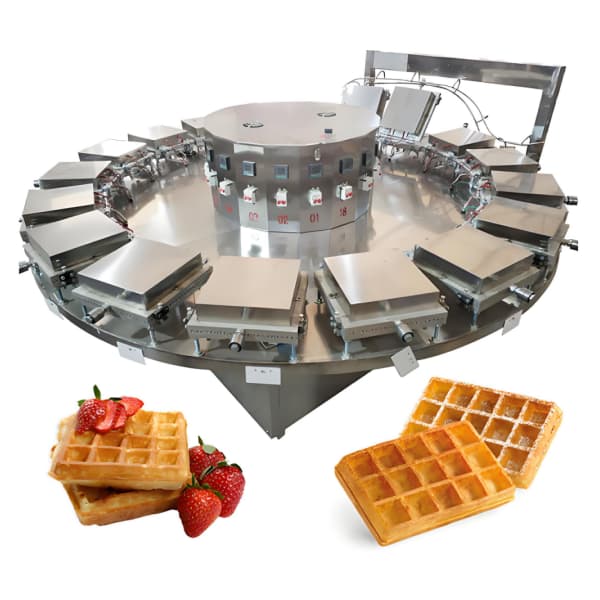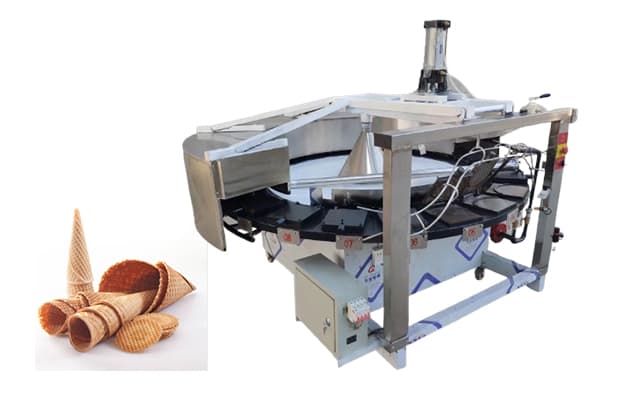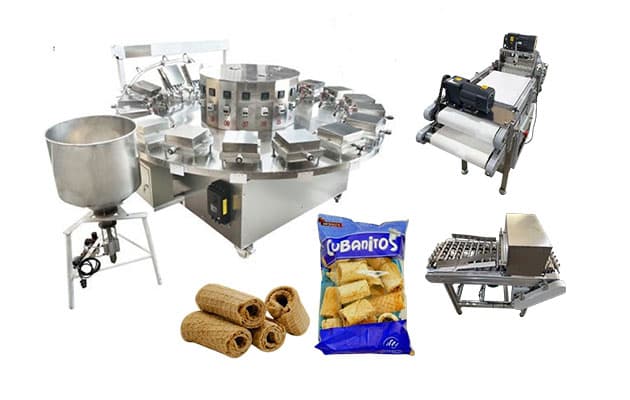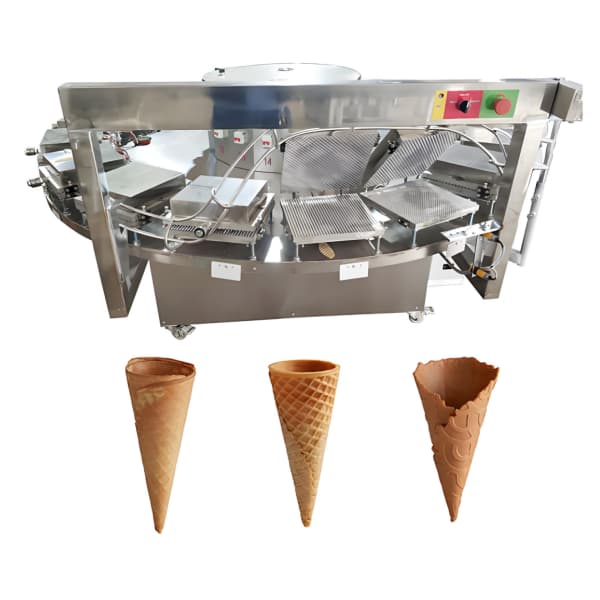Setting up an Machine à cornets de crème glacée—whether it is a fabricant de cornets de gaufres, sugar cone machine, wafer cone baking machine, or a fully ligne de production automatique de cornets de glace—is one of the most important steps before starting cone manufacturing. A properly installed machine ensures stable baking temperature, uniform cone color, grande efficacité, and long service life.
Many buyers purchase the equipment but do not know the correct installation procedure. This often leads to uneven baking, machine errors, or inconsistent cone quality. This guide will walk you through every step of installation, from workshop preparation to calibration and test production.

1. Why Proper Installation Is Crucial
Une haute qualité Machine à cornets de crème glacée can operate 24 hours continuously, but only when it is installed correctly.
Proper setup ensures:
- Stable heat distribution
- Optimal cone texture and crispiness
- Lower gas or electricity consumption
- Smoother production flow
- Coût de maintenance réduit
- Less downtime
- Qualité cohérente du produit
Incorrect installation may lead to:
- Burnt or undercooked cones
- Uneven cone color
- Batter leakage
- Excessive fuel use
- Broken or cracked cones
- Production interruptions
Donc, understanding the correct setup process is essential for any manufacturer starting a cone production business.
2. Preparing the Workshop Before Installation
Before placing the industrial cone maker, prepare the workshop according to machine requirements.
2.1 Exigences spatiales
Une norme rotary ice cream cone oven ou wafer cone baking machine needs:
- Clear space around the machine: 1–1.5 meters for maintenance
- A flat, level ground
- Smooth workflow space for operators
- Room for batter mixer, convoyeur, and packing station
For fully automatic production:
- Additional space for cooling conveyor
- Cone counting system
- Packaging section
2.2 Environmental Requirements
Ice cream cone production requires a controlled environment:
- Température: 10–35°C
- Humidité: <75%
- Dust-free and dry
- Good air circulation
- No direct sunlight on the baking section
High humidity may soften the cones or cause storage issues.
2.3 Energy Supply Preparation
Selon le type de machine:
Gas Heating Ice Cream Cone Machines
- LPG or natural gas line
- Gas pressure regulator
- Explosion-proof gas valve
- Steel or certified rubber pipes
- Proper ventilation
Electric Heating Ice Cream Cone Machines
- 380V three-phase
- Stable voltage (±5%)
- Proper grounding
- Voltage stabilizer (recommended for Africa, l'Amérique latine, South Asia)

3. Checking the Ice Cream Cone Machine Before Installation
When you receive the equipment, inspect the following components:
- Moules à cuisson / assiettes
- Gas burners or heating tubes
- Electrical cabinet
- Transmission chain
- Cone rolling molds
- Batter pump
- HMI/PLC control panel
- Convoyeur de refroidissement
- Des pièces de rechange (springs, ceintures, capteurs, fuses)
Check for transportation damage or loose fasteners.
4. Étape par étape: How to Set Up an Ice Cream Cone Machine
Below is the complete setup process for both semi-automatic cone makers et automatic industrial cone production lines.
Étape 1: Position the Machine Correctly
Place the waffle cone maker machine ou rotary wafer cone baking oven on a flat surface.
Requirements:
- Keep 1 meter space around
- Use a level ruler to ensure stability
- Avoid humid or uneven floors
- Leave space for batter feeding and cooling system
Correct placement prevents vibration and ensures even baking.
Étape 2: Connect the Gas System (If Applicable)
Gas-fired Machines à cône de sucre require stable pressure.
2.1 Pipeline Connection
Utiliser:
- Independent gas pipeline
- High-pressure regulator
- Steel pipes
- Teflon sealing tape
2.2 Gas Pressure Requirements
- GPL: 30–50 mbar
- Natural gas: 15–25 mbar
2.3 Safety Inspection
- Apply soap water to joints to check leakage
- Ensure exhaust fan is working
- Install emergency gas shutoff
Never start burners until leak testing is completed.

Étape 3: Connect the Electrical System
Even for gas heating machines, the controls require electricity.
Check the following:
- Grounding wire
- Main power switch
- Control cabinet wiring
- Relay connections
- Emergency stop function
- PLC/HMI boots successfully
Exigences électriques
- Three-phase 380V
- Stabilized voltage
- Secure grounding (<4Ω)
Étape 4: Install the Batter Mixing & Feeding System
Your ice cream cone processing machinery needs a consistent batter feeding system.
4.1 Batter Mixing Machine
Prepare batter with:
- Farine
- Sucre
- Eau
- Huile
- Arôme
Mix for 10–20 minutes for consistency.

4.2 Connect Batter Pump
- Use food-grade hoses
- Check for leaks
- Ensure smooth suction and output
4.3 Adjust Filling Amount (Dosing)
Dosing determines cone thickness:
- Small cones: 8–15g
- Medium cones: 12–25g
- Large cones: 20–40g
Adjust through PLC or mechanical valve depending on model.
Étape 5: Dry Run (No Batter)
Before adding batter, run the industrial cone maker empty.
Check:
- Transmission chain motion
- Plate rotation
- Gas flame condition
- Electric heating response
- Motor noise
- Temperature increase
Preheating usually takes 8–12 minutes.
Étape 6: Add Batter and Start Test Production
Once preheated, begin the first test batch.
- Start the dosing system
- Let batter enter molds
- Observe baking quality
- Check cone color uniformity
- Adjust thickness if needed
6.1 Contrôle de la température
Typical settings:
| Type de cône | Température |
|---|---|
| Wafer cones | 160–180°C |
| Cônes de sucre | 180–200°C |
| Chronomètres à gaufre | 190–220°C |
6.2 Temps de cuisson
Dépend du modèle:
- 45–90 seconds per cycle
Étape 7: Adjust the Cone Rolling System
The cone must be perfectly shaped.
Check:
- Tip closure
- Wall thickness
- Shape accuracy
- No cracks
Adjust:
- Rolling pressure
- Mold alignment
- Cone mandrel temperature
Étape 8: Cooling and Moisture Stabilization
Fresh cones are still soft.
Cooling is done via:
- Air cooling tunnel
- Conveyor belt
- Cooling tray
Cooling time: 2–6 minutes.
Proper cooling prevents deformation.
Étape 9: Final Quality Testing
Inspect:
- Cone color
- Crispiness
- Shape and angle
- Longueur
- Smoothness
- No bubbles or holes
Only after stable quality appears should the production start officially.

5. Common Issues and Solutions During Setup
Problème 1: Uneven cone color
- Uneven gas flame → clean burners
- Wrong temp → adjust heating
- Uneven dosing → calibrate pump
Problème 2: Batter leakage
- Plates not closed tightly → adjust hinge
- Too much batter → reduce dosage
Problème 3: Cones breaking easily
- Pressure too high → adjust forming mold
- Too little moisture → adjust recipe
Problème 4: Cônes collant aux assiettes
- Dirty molds → clean & huile
- Overheated plates → stabilize temperature
6. Exigences de sécurité
Gas Heating Safety
- Check leakage daily
- Install gas cutoff valve
- Maintain ventilation
- Keep fire extinguisher nearby
Electrical Safety
- No water near control cabinet
- Avoid overloading
- Tighten connections regularly
Operator Safety
- Use heat-resistant gloves
- Do not bypass safety sensors
- Keep clothing away from moving parts
7. Training Requirements for Operators
Every operator should learn:
- Batter mixing ratios
- Temperature and time control
- Proper dough feeding
- Mold adjustment
- Troubleshooting
- Daily cleaning procedures
Good training greatly reduces waste and improves efficiency.
8. Daily Operation Checklist
Before starting the machine:
- Preheat for 10 minutes
- Check gas or electricity
- Confirm dosing volume
- Clean molds
- Ensure chain lubrication
- Test cone quality every hour
9. Guide de maintenance
Tous les jours
- Clean plates
- Remove residue
- Wipe cone molds
Hebdomadaire
- Lubrifier les roulements
- Check chain tension
- Inspect burners
Mensuel
- Full machine inspection
- Safety test
- Check PLC and sensors
Avec une maintenance appropriée, ton Machine à cornets de crème glacée will last 8–12 years ou plus.

Set up Ice Cream Cone Machine
Setting up an Machine à cornets de crème glacée, qu'il’s a fabricant de cornets de gaufres, sugar cone production machine, industrial wafer cone baking equipment, ou automatic cone making line, is the key to ensuring stable production and high-quality cones.
By preparing the workshop correctly, connecting gas and electricity safely, calibrating dosing, adjusting molds, testing baking results, and training operators, your factory will achieve:
- Consistent cone color
- Grande efficacité
- Stable 24-hour operation
- Lower operating cost
- Faster ROI
